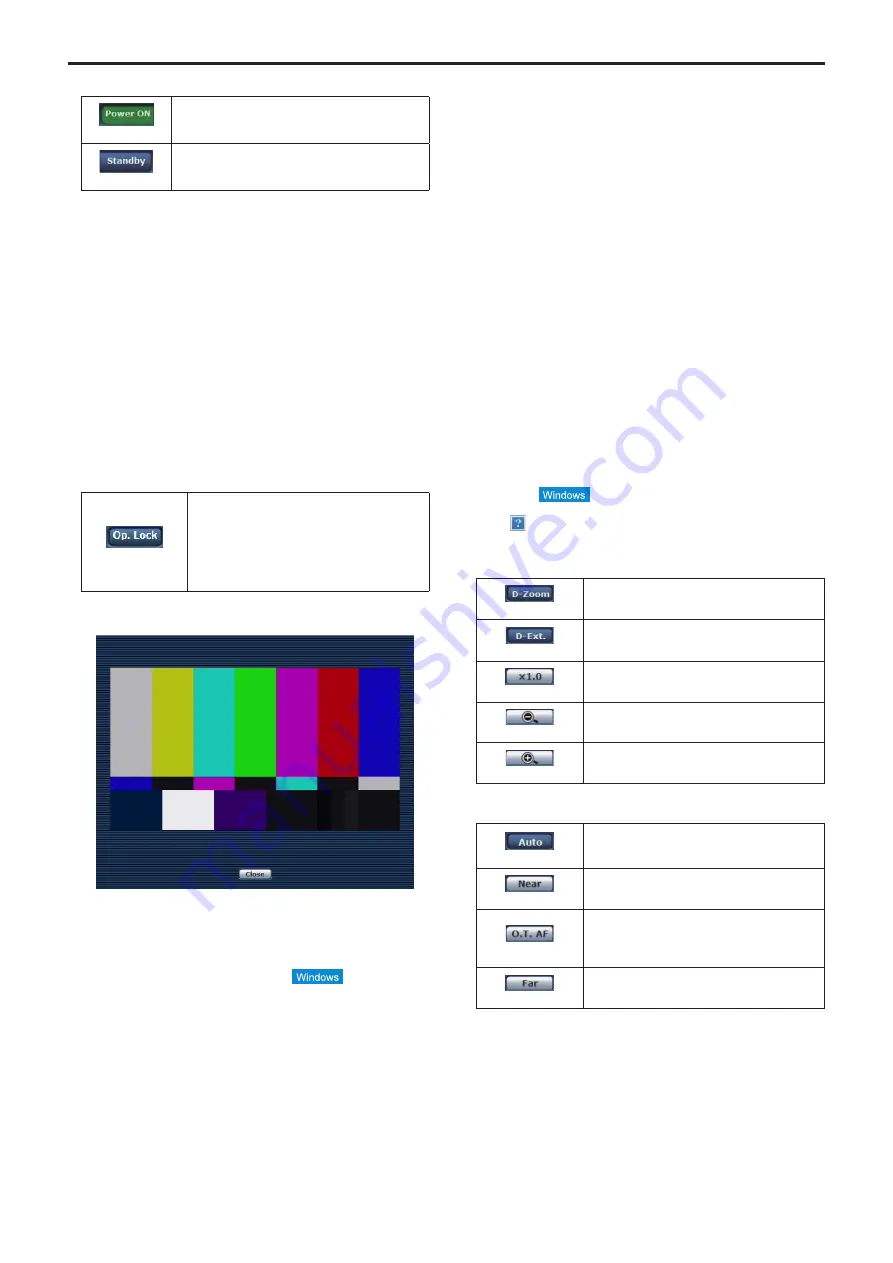
9.
Power ON button [Power ON] / Standby button [Standby]
[Power ON]
Turn the unit on.
[Standby]
Set the unit to Standby mode.
In the Standby mode, all the buttons on the live screen [Live] except
for the [Multi-screen] list box, [Power ON] button, [Standby] button
and [Op. Lock] button are disabled.
<NOTE>
• If [Power ON] or [Standby] is selected too quickly, the status
selected and the display shown may not correspond. In a case like
this, follow the steps below to restore the correct status display:
For Windows:
Press the [F5] key.
For Mac:
Press the [Command] + [R] keys.
•
When operation is transferred to the Standby mode:
The current zoom, focus and iris positions are stored in the memory
(Power ON preset).
•
When operation is transferred to the Power ON mode:
The zoom, focus and iris are adjusted to the positions which were
stored in the memory (Power ON preset) when operation was
transferred to the Standby mode.
10.
Operation lock button [Op. Lock]
[Op. Lock]
Use this to lock the operation of the pan, tilt,
zoom, focus, brightness, speed, preset and scene
operations on the control screen.
Use this also to lock the on-screen display menu
operations, [CAM/BAR] button and [Power ON]
button / [Standby] button to prevent operations
from being performed by accident.
11.
Main area (IP video display area)
The IP video of the connected camera will be displayed.
When the camera receives a tally signal, the area frame turns red.
The original display is redisplayed when the receiving of the tally
signal is canceled.
Operating the mouse wheel inside the display area allows you to use
the plug-in viewer softwareʼs digital zoom.
<NOTE>
• When the shooting scenes vary significantly, restrictions imposed
by the graphics processing (GDI) of the operating system installed
may give rise to a phenomenon called “screen tearing” (where parts
of the picture are not displayed in synchronization) although this will
depend on the personal computer used.
•
On a personal computer running Windows, if [H.264 transmission]
(→ page 68) is set to [On], H.264 images and JPEG images can
be displayed. When it is set to [Off], only JPEG images will appear.
• On a personal computer running OS X (Mac), regardless of the
[H.264 transmission] settings, only JPEG images will appear. (H.264
images will not appear.)
•
When [H.264 transmission] is set to [On], the frame rate for JPEG
images may drop, regardless of whether H.264 images are being
transmitted.
•
The speed at which the JPEG images are refreshed may be
reduced depending on the network environment, performance of the
personal computer used, subjects and number of access users.
•
Up to 14 users (consisting of users receiving H.264 images and
users receiving JPEG images) can access the unit at the same
time. (The maximum number of Android terminals which can be
connected to the unit at the same time is one.)
However, depending on the settings for the [Bandwidth control (bit
rate)] and [Max bit rate (per client)], the number of users who can
access the unit may be limited to less than 14.
• If the maximum number of users who can access the unit has
exceeded the upper limit, a message advising that the unit is being
accessed by more users than the maximum number allowed is
displayed.
• In the case of a personal computer which is running OS X (Mac),
the “
” icon appears in the center of the main area which is
displayed on a black screen.
12.
Zoom [Zoom]
[D-Zoom]
Use this to enable or disable the digital zoom.
[D-Ext.]
Use this to enable or disable the digital extender.
[×1.0]
Use this to adjust the zoom (magnification) to 1.0x.
[–]
Use this to adjust the zoom (magnification) in the
Wide direction.
[+]
Use this to adjust the zoom (magnification) in the
Tele direction.
13.
Focus [Focus]
[Auto]
Use this to switch between auto and manual
focusing. When Auto is selected, the focus is
adjusted automatically.
[Near]
Use this to adjust the focus in the Near direction.
It does not work during automatic adjustments.
[O.T. AF]
When this is pressed while the focus is being
adjusted manually, the focus will be temporarily
adjusted automatically.
It does not work during automatic adjustments.
[Far]
Use this to adjust the focus in the Far direction.
It does not work during automatic adjustments.
62
Web screen operations (continued)






























